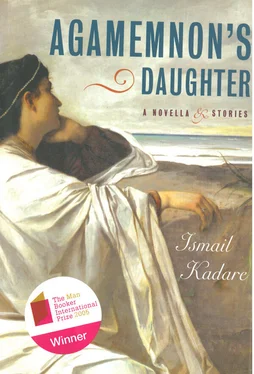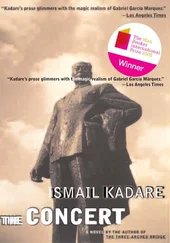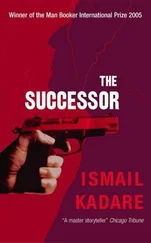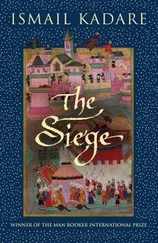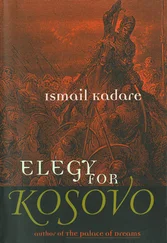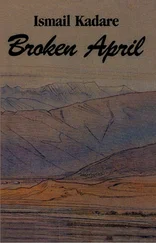As could be verified over the following weeks, the qorroffices were used less for collecting denunciations or for putting out eyes than for something quite different, throughout the entire campaign. Contrary to initial impressions, these locales, though as sinister and desolate as their name implied, became noisy and excitable gathering-places. People went there to find out how the campaign was proceeding, to get information on various details of the order or on the latest instructions from the central commission, to swap news about so-and-so who, after much shilly-shallying, had finally decided to turn himself in to have his eyes put out while singing the sovereign’s praises, and so on.
Some people actually enjoyed spending part of their time in the qorroffices. They even brought along the cup of coffee they’d picked up from the corner cafe to drink it there; others, mostly youngsters, played messenger, taking away letters and coming back with envelopes or instruction sheets issued by God knows who; and there were even some who indulged themselves in speechifying, describing in sonorous tones and with a strange light in their eyes all the benefits that would flow from the qorrfirman, as a result of which the world, finally cleansed of the evil eye and saved from the dreadful effect of its evil power, would be a finer, more splendid place.
The almost festive atmosphere in the qorroffices was occasionally interrupted by the sudden entrance of a group of panting, cursing men dragging a carrier of the evil eye who had been caught in the act, or some other poor fellow convicted of having slighted the royal order.
However, despite the fact that the qorrofftces had lost their sinister appearance and become more like public places, everyone agreed that it would not be at all easy to implement the Blinding Order. The central commission had issued a directive listing five acceptable ways of putting out eyes: the Byzantino-Venetian method (an iron bar forking into two sharpened tips); the Tibetan method (which involved piling heavy stones on the convict’s chest until his eyes popped out of their sockets); the local method (using acid); the Romano-Carthaginian method (sudden exposure to a bright light); and the European method (protracted incarceration in total darkness).
The same directive also stipulated that people who turned themselves in, as well as some others who for various reasons were judged by the commission to deserve the privilege, would not only receive the regular monetary compensation but would have the right to choose the method of their own blinding.
It was easy to guess the two methods that would be chosen most often, and, moreover, be considered a signal favor by their victims, as being the Romano-Carthaginian and the European. Apart from the fact they were painless, both methods left the victim’s eyes untouched, resulting in no empty sockets or mutilation of the face.
The only difference between them was the length of the procedure. Whereas only two or three minutes of forced exposure to the sun was needed to blind the victim in the first case, in the second it required as much as three months of blindfolding for the sudden withdrawal of the wrap to provoke instant and total blindness.
The Romano-Carthaginian method, quite apart from the fact that it did not involve any psychological torture (long months spent in total darkness with depressing memories weighing down on you, and so forth), was carried out in conditions of blistering cleanliness, since it was based on the action of sunlight. As a result it rapidly became the preferred method among volunteers, as among other suspects, often from the higher social classes, who had no special protection from the qorrfirmaris wrath.
As for the other techniques based on force, compounding physical pain with mutilation and the lack of financial compensation, it was hard to say which was the most repulsive. The difficulty of choosing among them was, as people later explained, the reason for the hesitation often observed among victims, who dallied until, in the end, they asked their executioners to choose, begging them to bring their suffering to an end as quickly as they could.
With the promulgation of the instructions on the five different blinding techniques came other emergency measures that clearly indicated full implementation of the Blinding Order was imminent. The Medical High School launched an accelerated training program in ophthalmectomy, several iron yards in the capital completed their first batches of forked iron bars for the Byzantino-Venetian style of blinding, and other workshops began the manufacture of acid, which was stored in small and sturdy kegs intended to make sure it would survive lengthy transportation to the remotest provinces of the Empire. But nothing special was needed for the Tibetan method. Large stones could be found anyplace, and no particular preparation was called for.
3
Marie concentrated on finishing the domestic chores she shared with her sister-in-law, then, saying she had a migraine, went up to her room. Her sister-in-law scowled. They were both very young (there was barely a year between them), and they were in the habit of sitting down to gossip after the housework was done each day, until Marie’s mother came to put a stop to their girlish chatter. “She worries that I might be telling you the secrets of my married life!” Marie’s sister-in-law used to say with a muffled giggle. Marie, for her part, bit her lip.
She had heard a few of the secrets, actually, especially the day before her engagement was made official, and then more in the course of the following few weeks. Her eyes blazed with curiosity as she drank in her sister-in-law’s sparse words, constrained by modesty and good manners to a mere trickle — whereas she thirsted for a raging torrent, as if she were lost in a desert.
But just recently, to the great surprise of her sister-in-law, who was inclined to be more open about things as Marie’s wedding day drew near, the young woman had stopped asking about intimate matters.
The sister-in-law shrugged. What could you expect from a family of lunatics whose different members followed different religions?
She had been genuinely surprised when she found out that the family of her future husband, like many households of Albanian descent, had maintained over the generations the custom of including within its bosom members of different, that is to say opposite, faiths. Her father-in-law, Aleks Ura, was a Christian, but one of his sons, who had gone into the navy, had been brought up a Muslim; whereas the other, her future husband, remained a Christian. Maybe the father would have done the same with daughters had he had two of them, but since Marie was the only one, he had tried, in a sense, to split her in two. As he could not raise her in two different faiths at the same time (though such cases were not unheard of), he had given her two first names, each from a different religion. So for her first family and close friends, her name was Marie; for the rest of the world, including her fiancé, it was Miriam.
Her future husband had tried to explain to her the reasons for such duplication, which had to do with the fate and history of their far-off homeland, Albania, but she did not really get much out of his knotty explanations. All that was plain in her eyes was that the brothers of Aleks had followed two different faiths, and that their forebears and ancestors had always done the same.
In the course of the several weeks during which preliminary discussions relating to her engagement were held, she had been astonished at her own family’s determination to become allied to this strange tribe, but it was not long before she learned the truth. The house she was going to join was related — distantly, it is true, but related nonetheless — to the famous Köprülü clan. To the degree that its name, Ura, was none other than the former and original patronymic of the Quprilis — translated, for reasons of state, from Albanian into the Ottoman Köprülü.
Читать дальше
